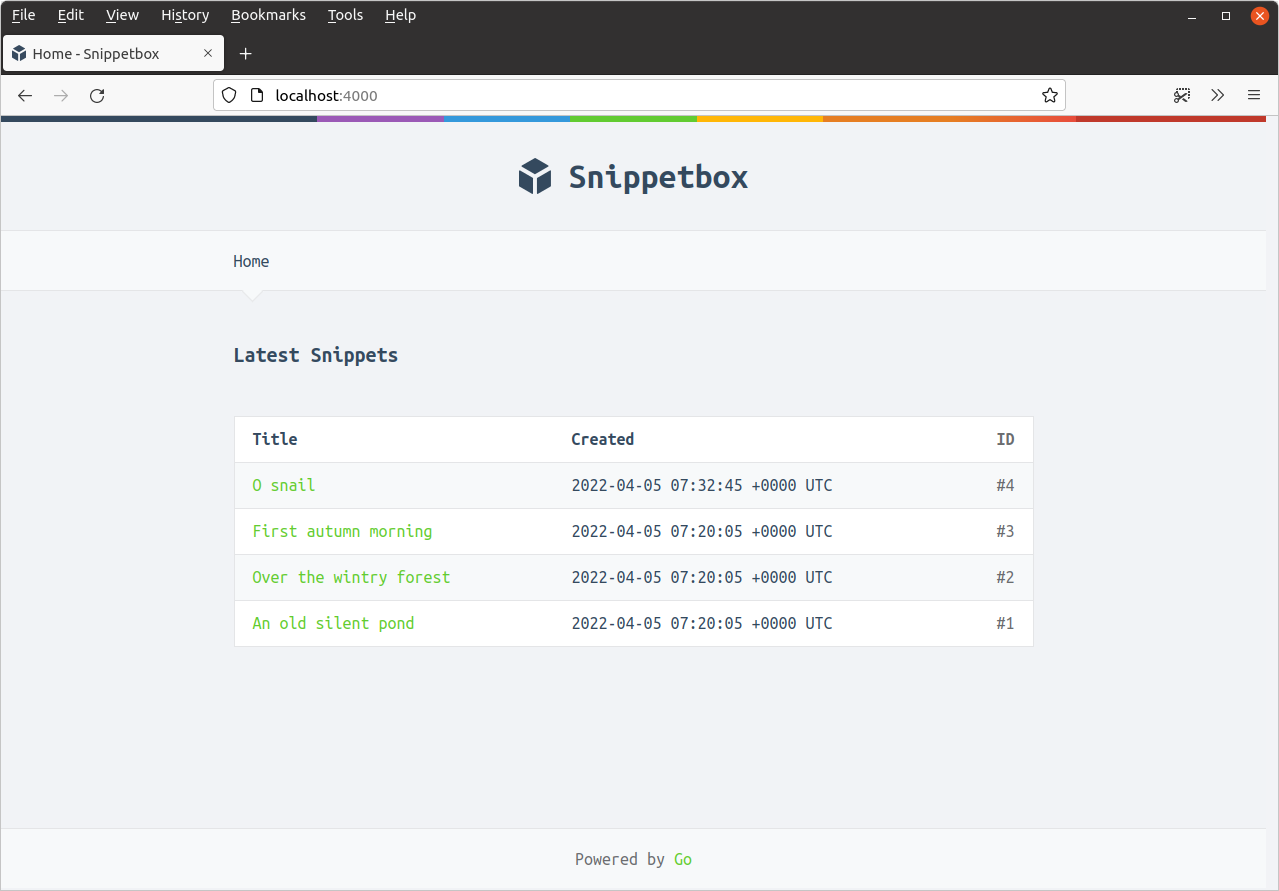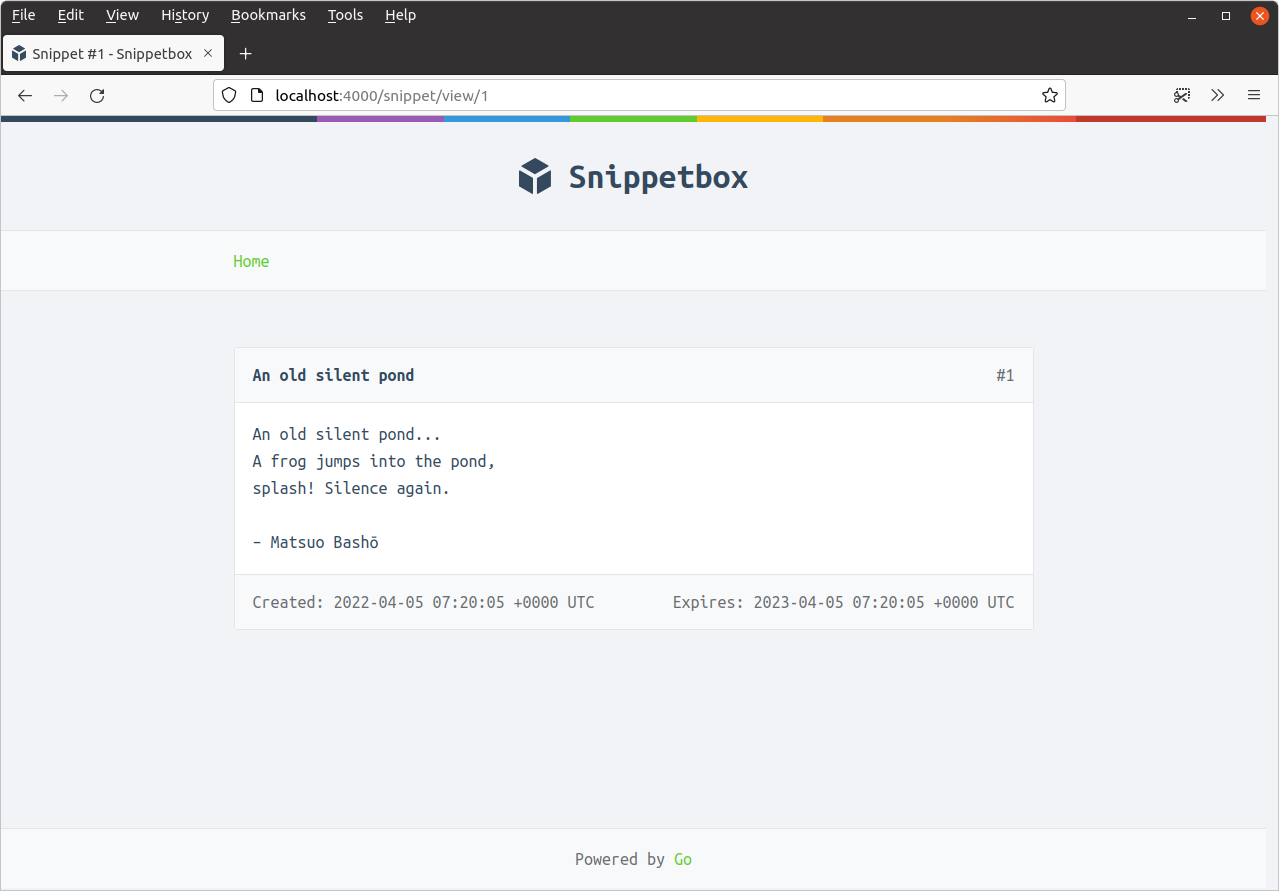Caching templates
Before we add any more functionality to our HTML templates, it’s a good time to make some optimizations to our codebase. There are two main issues at the moment:
Each and every time we render a web page, our application reads and parses the relevant template files using the
template.ParseFiles()function. We could avoid this duplicated work by parsing the files once — when starting the application — and storing the parsed templates in an in-memory cache.There’s duplicated code in the
homeandsnippetViewhandlers, and we could reduce this duplication by creating a helper function.
Let’s tackle the first point first, and create an in-memory map with the type map[string]*template.Template to cache the parsed templates. Open your cmd/web/templates.go file and add the following code:
package main import ( "html/template" // New import "path/filepath" // New import "snippetbox.alexedwards.net/internal/models" ) ... func newTemplateCache() (map[string]*template.Template, error) { // Initialize a new map to act as the cache. cache := map[string]*template.Template{} // Use the filepath.Glob() function to get a slice of all filepaths that // match the pattern "./ui/html/pages/*.tmpl". This will essentially gives // us a slice of all the filepaths for our application 'page' templates // like: [ui/html/pages/home.tmpl ui/html/pages/view.tmpl] pages, err := filepath.Glob("./ui/html/pages/*.tmpl") if err != nil { return nil, err } // Loop through the page filepaths one-by-one. for _, page := range pages { // Extract the file name (like 'home.tmpl') from the full filepath // and assign it to the name variable. name := filepath.Base(page) // Create a slice containing the filepaths for our base template, any // partials and the page. files := []string{ "./ui/html/base.tmpl", "./ui/html/partials/nav.tmpl", page, } // Parse the files into a template set. ts, err := template.ParseFiles(files...) if err != nil { return nil, err } // Add the template set to the map, using the name of the page // (like 'home.tmpl') as the key. cache[name] = ts } // Return the map. return cache, nil }
The next step is to initialize this cache in the main() function and make it available to our handlers as a dependency via the application struct, like this:
package main import ( "database/sql" "flag" "html/template" // New import "log/slog" "net/http" "os" "snippetbox.alexedwards.net/internal/models" _ "github.com/go-sql-driver/mysql" ) // Add a templateCache field to the application struct. type application struct { logger *slog.Logger snippets *models.SnippetModel templateCache map[string]*template.Template } func main() { addr := flag.String("addr", ":4000", "HTTP network address") dsn := flag.String("dsn", "web:pass@/snippetbox?parseTime=true", "MySQL data source name") flag.Parse() logger := slog.New(slog.NewTextHandler(os.Stdout, nil)) db, err := openDB(*dsn) if err != nil { logger.Error(err.Error()) os.Exit(1) } defer db.Close() // Initialize a new template cache... templateCache, err := newTemplateCache() if err != nil { logger.Error(err.Error()) os.Exit(1) } // And add it to the application dependencies. app := &application{ logger: logger, snippets: &models.SnippetModel{DB: db}, templateCache: templateCache, } logger.Info("starting server", "addr", *addr) err = http.ListenAndServe(*addr, app.routes()) logger.Error(err.Error()) os.Exit(1) } ...
So, at this point, we’ve got an in-memory cache of the relevant template set for each of our pages, and our handlers have access to this cache via the application struct.
Let’s now tackle the second issue of duplicated code, and create a helper method so that we can easily render the templates from the cache.
Open up your cmd/web/helpers.go file and add the following render() method:
package main import ( "fmt" // New import "net/http" ) ... func (app *application) render(w http.ResponseWriter, r *http.Request, status int, page string, data templateData) { // Retrieve the appropriate template set from the cache based on the page // name (like 'home.tmpl'). If no entry exists in the cache with the // provided name, then create a new error and call the serverError() helper // method that we made earlier and return. ts, ok := app.templateCache[page] if !ok { err := fmt.Errorf("the template %s does not exist", page) app.serverError(w, r, err) return } // Write out the provided HTTP status code ('200 OK', '400 Bad Request' etc). w.WriteHeader(status) // Execute the template set and write the response body. Again, if there // is any error we call the serverError() helper. err := ts.ExecuteTemplate(w, "base", data) if err != nil { app.serverError(w, r, err) } }
With that complete, we now get to see the payoff from these changes and can dramatically simplify the code in our handlers:
package main import ( "errors" "fmt" "net/http" "strconv" "snippetbox.alexedwards.net/internal/models" ) func (app *application) home(w http.ResponseWriter, r *http.Request) { w.Header().Add("Server", "Go") snippets, err := app.snippets.Latest() if err != nil { app.serverError(w, r, err) return } // Use the new render helper. app.render(w, r, http.StatusOK, "home.tmpl", templateData{ Snippets: snippets, }) } func (app *application) snippetView(w http.ResponseWriter, r *http.Request) { id, err := strconv.Atoi(r.PathValue("id")) if err != nil || id < 1 { http.NotFound(w, r) return } snippet, err := app.snippets.Get(id) if err != nil { if errors.Is(err, models.ErrNoRecord) { http.NotFound(w, r) } else { app.serverError(w, r, err) } return } // Use the new render helper. app.render(w, r, http.StatusOK, "view.tmpl", templateData{ Snippet: snippet, }) } ...
If you restart the application and try visiting http://localhost:4000 and http://localhost:4000/snippet/view/1 again you should see that the pages are rendered in exactly the same way as before.


Automatically parsing partials
Before we move on, let’s make our newTemplateCache() function a bit more flexible so that it automatically parses all templates in the ui/html/partials folder — rather than only our nav.tmpl file.
This will save us time, typing and potential bugs if we want to add additional partials in the future.
package main ... func newTemplateCache() (map[string]*template.Template, error) { cache := map[string]*template.Template{} pages, err := filepath.Glob("./ui/html/pages/*.tmpl") if err != nil { return nil, err } for _, page := range pages { name := filepath.Base(page) // Parse the base template file into a template set. ts, err := template.ParseFiles("./ui/html/base.tmpl") if err != nil { return nil, err } // Call ParseGlob() *on this template set* to add any partials. ts, err = ts.ParseGlob("./ui/html/partials/*.tmpl") if err != nil { return nil, err } // Call ParseFiles() *on this template set* to add the page template. ts, err = ts.ParseFiles(page) if err != nil { return nil, err } // Add the template set to the map as normal... cache[name] = ts } return cache, nil }